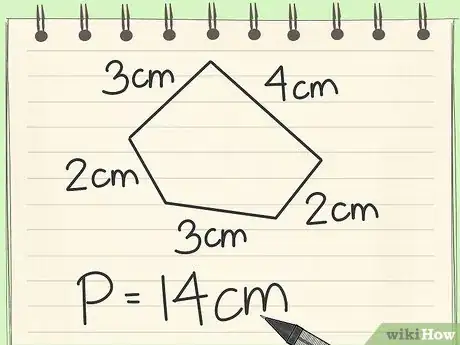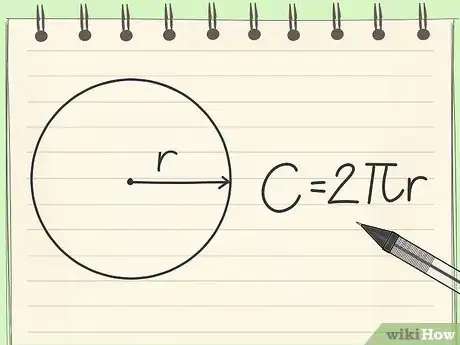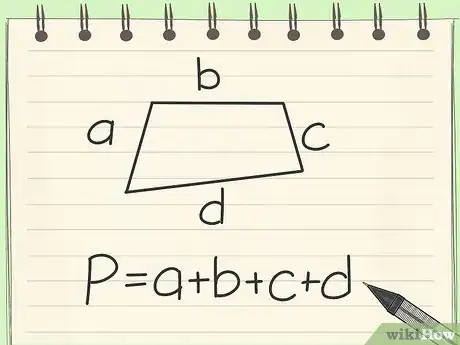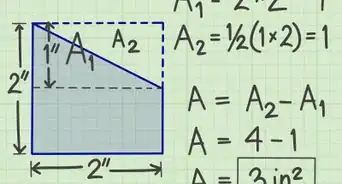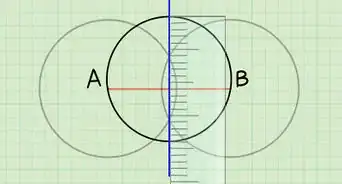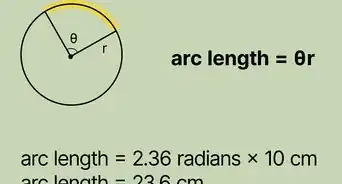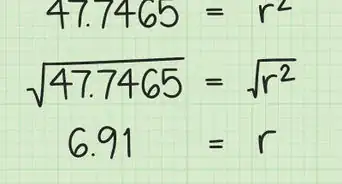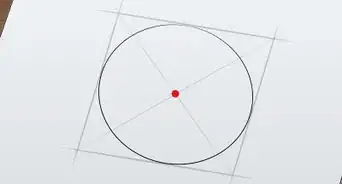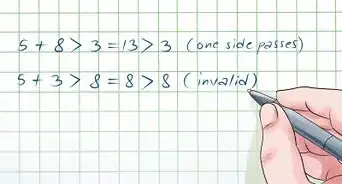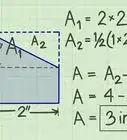This article was co-authored by David Jia. David Jia is an Academic Tutor and the Founder of LA Math Tutoring, a private tutoring company based in Los Angeles, California. With over 10 years of teaching experience, David works with students of all ages and grades in various subjects, as well as college admissions counseling and test preparation for the SAT, ACT, ISEE, and more. After attaining a perfect 800 math score and a 690 English score on the SAT, David was awarded the Dickinson Scholarship from the University of Miami, where he graduated with a Bachelor’s degree in Business Administration. Additionally, David has worked as an instructor for online videos for textbook companies such as Larson Texts, Big Ideas Learning, and Big Ideas Math.
This article has been viewed 100,828 times.
Perimeter is a measure of the area or distance around a two-dimensional shape. On a rectangle, for instance, the perimeter is the total length of the rectangle's outline, including the two widthwise borders and the two lengthwise borders. To determine the perimeter of a shape, therefore, you add together all the dimensions that make up the shape's outer edge. Being able to find the perimeter of a shape has many applications in the real world. Say, for example, that you wanted to build a fence around your backyard. In order to purchase materials, you need to know how much fencing you'll need, and to determine that you have to figure out the perimeter of the area you want to fence in.
Steps
Finding the Perimeter of Most Shapes
-
1Determine the length of each side. Since perimeter is just a measure of the outline of a two-dimensional figure, you don't usually need a specific formula to find perimeter (though there are equations for specific shapes to make it easier). However, you do need to know the length of all the sides of the shape.[1]
- For example, a pentagon has five sides, and you need to know the length of each one to determine perimeter.
- Even with an irregular polygon that has 20 sides, you can still find the perimeter as long as you know the length of each side.
-
2Add the length of all the sides together. To find the perimeter of non-circular objects, find the sum of all the side lengths to determine the distance around the shape.[2]
- Say the irregular pentagon has the following lengths: A = 4, B =2, C = 3, D = 3, and E = 2
- Add 4 + 2 + 3 + 3 + 2 = 14, where P (perimeter) = 14
Advertisement -
3Deal with variables. You can still find perimeter when you are working with variables. For example, say you have a triangle with the side lengths 14a, 11b, and 7a:[3]
- Find the sum of all the sides: P = 14a + 11b + 7a
- Combine the like terms: P = (14a + 7a) + 11b
- P = 21a + 11b
-
4Pay attention to units of measurement. In a real world application, finding the perimeter of an object won't do you much good if you don't know what unit of measurement you're working with (such as feet, miles, or meters). With the pentagon, if each side was measured in centimeters, then you know that P = 14 cm.
Learning Perimeter Formulas
-
1Find the perimeter of a circle. Some regular shapes have formulas that make it faster for you to find the figure's perimeter. But there are other shapes, like circles, that require a formula to find perimeter. The perimeter of a circle is called the circumference. To find the circumference of a circle, use the equation C (circumference) = 2πr.[4]
- To start, find the radius of the circle, which is the length of a line segment running from the center of the circle to the perimeter.
- For simpler equations, use the truncated version π = 3.14
- For a circle with a radius of 4cm: C = 2 x 3.14 x 4 = 25.12cm
-
2Find the perimeter of a triangle. Use the equation P = a + b + c for a triangle. For instance, if a triangle has the dimensions a = 20cm, b = 11cm, and c = 9cm, then P = 20 + 11 + 9 = 40cm.
-
3Find the perimeter of a square. Because a square has four sides of the same length, you can use the simple equation P = 4x, where x equals the length of one side.
- On a square where x = 3cm, then P = 4 x 3 = 12cm
-
4Find the perimeter of a rectangle. Since the lengthwise sides are the same and the widthwise sides are the same on a rectangle, you can use the equation P = 2l + 2w, where l is the length of one side and w is the width of one side. For a rectangle where l = 8cm and w = 5cm:
- P = (2 x 8) + (2 x 5)
- P = 16 + 10
- P = 26cm
- The equation P = 2(l + h) will also give you the same result: 2(8 + 5) = 2(13) = 26cm[5]
-
5Find the perimeter of other quadrilaterals. A quadrilateral refers to any two-dimensional shape with four closed, straight sides. This includes rectangles, squares, trapezoids, parallelograms, kites, and rhombuses.[6] There are three equations you can use for a quadrilateral, depending on the sides:
- For a quadrilateral with no equal sides, like an irregular trapezoid, use the equation P = a + b + c + d
- For a quadrilateral with four equal sides, use the same equation as a square: P = 4x.
- For quadrilaterals where the lengthwise sides are the same and the widthwise sides are the same (like a rectangle), use the equations P = 2a + 2b or P = 2(a + b)
Community Q&A
-
QuestionHow do I find the perimeter of an irregular shape, not regular?
 DonaganTop AnswererThe only way to calculate the perimeter of an irregular shape is to add together the lengths of all the sides. If you're not given those lengths, you may be given other information that could help you find those lengths.
DonaganTop AnswererThe only way to calculate the perimeter of an irregular shape is to add together the lengths of all the sides. If you're not given those lengths, you may be given other information that could help you find those lengths. -
QuestionWhat is the difference between wide and long?
 DonaganTop AnswererIn the case of a rectangular shape, its length is normally considered to be the longer of its two dimensions, while its width is the shorter.
DonaganTop AnswererIn the case of a rectangular shape, its length is normally considered to be the longer of its two dimensions, while its width is the shorter. -
QuestionSquare tiles 30 cm by 30 cm are used to cover a floor. How many tiles are needed to cover a floor measuring 4.5 m long and 3.9 m wide?
 DonaganTop AnswererConvert the floor measurements to centimeters: 450 cm x 390 cm. Divide each of those measurements by 30. Then multiply the two quotients together. That's how many tiles you'll need. In this case you shouldn't have any partial tiles left over.
DonaganTop AnswererConvert the floor measurements to centimeters: 450 cm x 390 cm. Divide each of those measurements by 30. Then multiply the two quotients together. That's how many tiles you'll need. In this case you shouldn't have any partial tiles left over.
References
About This Article
To find the perimeter of a shape, just add the lengths of all of the sides together. If you're trying to find the perimeter of a circle, you'll need to use the formula c = 2πr, where c is the circumference and perimeter, and r is the radius of the circle. If you want to learn formulas for how to find the perimeter of specific shapes, keep reading the article!



